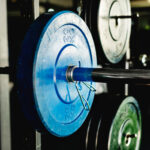Q and A
Q: I saw that you previously answered a post in your Locker Room about best tips for hockey players.
What are come general recommendations you would give to a sprinter? Thanks!
A: People have written entire books on this topic, and admittedly this isn’t my area of expertise. However, I do have some general thoughts on the matter that I’d like to drive home.

Generally speaking I’d say:
1. Strengthen the Posterior Chain– you want to run fast, you need to train ass. How’s that for a slogan? Someone needs to make that into a t-shirt, stat.
I’m not going to go into an exhaustive list of exercises you can do, but suffice it to say, as an athlete, you’d be remiss to neglect your posterior chain (glutes, hamstrings, upper/lower back, etc).
Likewise, and this is completely un-related to the question above- you’d also be remiss not to recognize that this badonkadonk deserves it’s own zip code.

YOWSA!!! I can’t tell if that’s a BOSU ball in the background or a Russian satellite crashing back to Earth from the shear gravitational pull of that thing. Am I right, or am I right? Hint: I am.
2. Soft Tissue Work– If I’ve said it once, I’ve said it twice—-do your foam rolling. It still boggles my mind that people don’t recognize it’s importance. Even today, this is STILL an often neglected component of basic programming. In short, this should be done several times per week, if not every day.
3. More Lateral Movement– For obvious reasons, sprinters are very “linear” in their training. It wouldn’t hurt, however, to include more lateral training into the mix. What this simply means is that you could add in some 25 yd shuttle runs, or anything that forces you to change direction for that matter. Not only will it help improve movement quality (we don’t always walk or run in a straight line), but it will also be more metabolically demanding to boot.
4. Distance Running- Don’t do it, for the love of god. You want to get better at sprinting, then you should sprint. Nuff said. To that end, try to read anything and everything by Charlie Francis and/or Vern Gambetta. Like I said above, I’m not expert in this area, but those two are the “go to” guys when it comes to sprinting and sprint mechanics.
5. Core Work- I have yet to meet an athlete (or weekend warrior for that matter) who couldn’t use more direct core training. Despite what many strength and conditioning coaches will say, squats and deadlifts are NOT all you need to hit your core. Specifically, I’m looking to improve core stability. The more “stable” we are, the more efficient we are at transferring force from the lower body to the upper body, which is kind of important when we’re discussing athletic performance.
6. Weekly massage or manual therapy work- We do preventative maintenance for our cars (oil changes, rotate tires, etc), so it only makes sense that we should do the same for our own bodies as well.

7. Condense your training stress. It stands to reason that sprinters, sprint a lot. Couple that with the amount of leg work done in the weight room, and you can surmise that the legs get pretty beat up.
If you can pull it off, I’d do 1-2 days per week of double sessions. On days you train your lower body (squats, deadlifts, single leg work, etc), try to do your sprint work in the AM, and iron work in the PM. Doing so will go a long ways in keeping you fresh, and less beat up as the weeks pass.
On an aside, there’s going to be a lot of autonomy here. Every person has their own strengths/weaknesses, postural issues, pathologies, injury history, etc. There’s obviously going to be some degree of “individualization” here, and I certainly can’t do this within the context of a blog post.
Generally speaking, most athletes need the same stuff——-get them stronger, improve movement quality, and above all, keep them healthy.
That being said, your job as a strength coach (or even if you train yourself) is to not hurt your athletes, or yourself! Dan John talked about this in one of his lectures not too ago. In short, the first role of a strength coach is “DO NO HARM.” There’s absolutely no need to get too advanced here. Keep it simple, and don’t do stupid stuff like squatting on a BOSU ball, or perform 1RM testing for leg extensions.
Believe it or not, we received a book at CP the other day where the author (I’m not going to name names) suggested 1RM leg extensions, among other things that were equally “vomit in my mouth” worthy. I know Alwyn Cosgrove will say that no book will make you dumber, but I’m borderline mentally retarded after reading that book.
All in all, I hope that helps. Certainly not an exhaustive list, but I think it provides some general guidelines that should be useful.


